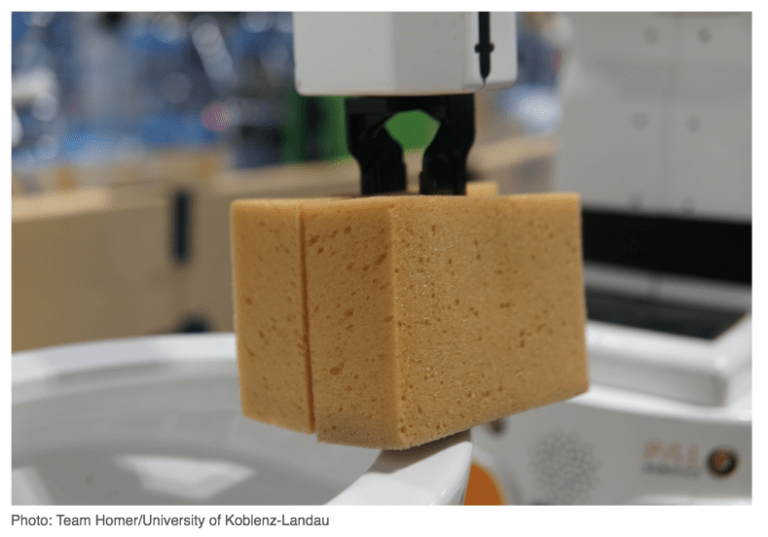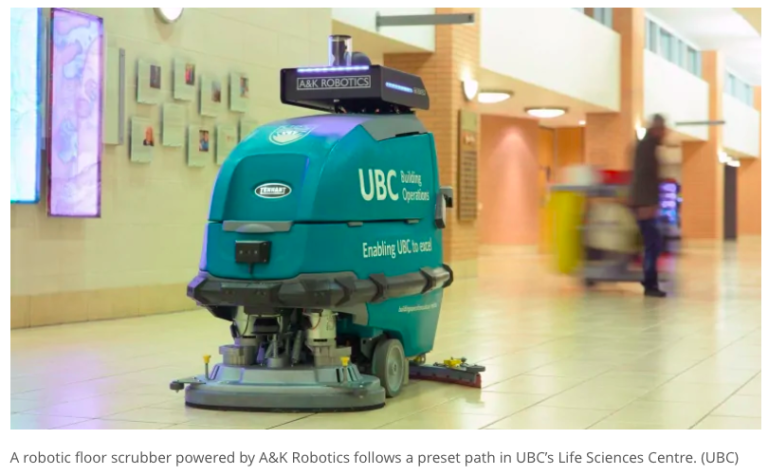The 1996 discovery of Allan Hills 84001 changed the world of science, and by extension robotics. I am referring to the meteorite that Dave McKay of NASA found on Earth, which hinted at life on Mars. Fast forward to the AI Summit two weeks ago, when I sat down with Stephen Gorevan of HoneyBee Robotics to discuss NASA’s Mars rover program’s artificial intelligence applications. Gorevan explained how HoneyBee’s geologic instruments deployed on Opportunity and Curiosity leverage deep learning software for communication and control systems that analyze extracted ore. Gorevan further pontificated that machine learning in unstructured environments is best utilized at targeted fields like Space exploration; cautioning the packed Javits Convention Center to ignore the hype. He exclaimed, “Sure, I can build a robot capable of cleaning toilets, but it would cost $800,000, and who would what that?”
Ironically, last month a robot toilet cleaning competition ensued at the World Robot Summit. The conference held in Japan aims to “Brings together Robot Excellence from around the world, to promote a world where robots and humans successfully live and work together.” The host country is famously augmenting its aging citizens with robots to maintain its standard of living by programming machines to take over menial tasks, like sanitizing washrooms. Due to Japans strict immigration laws, growing geriatric citizenry, and low birth rate, by 2050 the country is estimated to lose one-third of its population. Team Homer, out of the University of Koblenz-Landau, won the bathroom challenge with its mobile manipulator to the cheers of the entire Japanese hall. Evan Ackerman of IEEE Spectrum observed, “You could imagine that in the (sort of) near future, hotels might use teams of humans and robots to service rooms, with the humans doing the tricky tidying up (and probably making the bed), while the robots do the floors and bathroom.”
A week prior to Homer’s achievement, I spoke with SOMATIC a New York-based automated cleaning team. Using a similar approach as Homer, the local roboticists explained how they utilize virtual reality to train their robotic arms to sanitize even the most nauseating water closets. SOMATIC is planning on selling its novel system as a service to the commercial janitorial market. In validating this proposition, I reached out to c, Chief Executive, of Alliance Building Services. Alliance is one of the leading building maintenance companies in the USA, responsible for servicing 60 million square feet in the New York area. Green indicated that New York’s unions would prevent the adoption of such technologies like SOMATIC in the near-term. Organized labor in the Big Apple’s is infamous for their aggressive tactics, which include blocking building entrances with two-story high blow up rats when employers hire non-union workers. Michael Levy, SOMATIC’s CEO, responded, “We support the rights of workers to organize and will work hard to provide assistance for important retraining programs. Technology lifts up all people over time and helps society progress.”
While janitorial services is probably one of the most unsexy areas of automation, it has been making headlines with the adoption of unmanned mops. Earlier this month, Walmart announced that it has engaged Brain Corporation to automate its floor scrubbing operations across the United States. The unicorn startup, backed by SoftBank, plans to roll out its unmanned platform to 360 locations by the end of 2019. John Crecelius, Walmart’s Vice President, declared: “We’re excited to work with Brain Corp in supporting our retail operations and providing our associates with a safe and reliable technology. BrainOS is a powerful tool in helping our associates complete repetitive tasks so they can focus on other tasks within the role and spend more time serving customers.” In explaining his solution, Brain Corp. founder and CEO, Eugene Izhikevich says “We can take anything that has wheels and turn it into a fully autonomous robot, provided that it can go slow and stopping is never a safety concern. And it’s more than just navigation. It is to robots what Android operating system is to smartphones.” Competing with Brain is a handful of other startups, including A&K Robotics spun out of The University Of British Columbia (BCU) in Vancouver. A&K recently rolled out units onto the floor of Vancouver’s International Airport. When asked about Brain, founder Jessica Yip responded, “We are trying to make the best technology and we are competing head-on against big American companies that have a lot more resources, much bigger sales and marketing teams than us.” However, she boasted that unlike competing solutions that require large capital outlays for an end-to-end system, A&K is affordably priced around $10,000 since it converts existing manual equipment into autonomous ones with its proprietary sensor packages. She added that her user interface is “super intuitive” and rivals any competitor.
Wondering if the commercial real estate industry would follow Walmart’s lead in automating cleaning, I pressed Green for answers. His office replied, “Not sure it’s worth commenting on this as we don’t currently use any of this technology due to the type of space we clean. Walmart stores and facilities have huge open areas and hallways where this makes sense and saves on labor.” Green’s office continued to explain, “Feedback from vendors have indicated that current technology does not do well in corners and edges, therefore, needing an employee to work behind it. Defeating the purpose of reducing labor expense.” According to the Bureau of Labor Statistics over 2.1 million people are currently employed in the cleaning services industry, with an average salary of $28,000. A machine that requires additional work and costs three times the price of an hourly worker makes no economic sense at this point. Green did seem to indicate that it is on his radar as, “We will be attending demos of this newer technology, however in the meantime its used primarily in settings such as airports, warehouses, retail, supermarkets, and schools.”
Hourly workers already feel the pressure from the press of Amazon Go and now Walmart’s push to mechanize its 1.5 million-strong workforce. Jaime Contreras of 32BJ SEIU Baltimore, which represents 18,000 janitors, quipped, “People want a real human cleaning their offices and protecting their buildings. Automated technology is not the same as having a live person to communicate with and to make sure that your building is safe. The commercial real estate market, which is growing and profitable, can afford to help keep men and women working so they can best support our communities and economy.” Adhering to Gorevan’s advice, I recall Ackerman’s sobering report of the World Robot Summit, “The biggest obstacle to cleaning robots like these is, sadly, probably not related to robotics hardware or software. It’s that humans are really good at cleaning bathrooms, really fast at cleaning bathrooms, and really cheap at cleaning bathrooms. We don’t want to clean bathrooms, but we’ll do it anyway, and it’s likely that most of us won’t be willing to pay all that much for a robot that’s able to do that and nothing else.”






